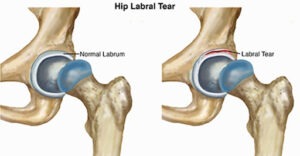Labral Tear
 Labrum tear is of several forms and can be easily confused. It’s vital that you discuss all your symptoms with your physician so they can ascertain the type of tear you have. Southern California Hip Institute (SCHI), led by board certified orthopedic surgeon Dr. Tigran Garabekyan, provides orthopedic surgery as well as non-surgical orthopedic treatments to patients in Los Angeles, Century City, CA, and surrounding locations.
Labrum tear is of several forms and can be easily confused. It’s vital that you discuss all your symptoms with your physician so they can ascertain the type of tear you have. Southern California Hip Institute (SCHI), led by board certified orthopedic surgeon Dr. Tigran Garabekyan, provides orthopedic surgery as well as non-surgical orthopedic treatments to patients in Los Angeles, Century City, CA, and surrounding locations.
Types of Labrum Tear
There are three types of labrum tears:
- The labrum will be completely torn away from the bone
- There will be tearing within the labrum
- The tear would be present in the area where the tendon of the bicep gets attached to the upper end of the socket
Diagnosing Labral Tear
There are two tests to diagnose a labral tear:
- Magnetic resonance imaging (MRI) scans
- CT-arthrogram (this is a type of CAT scan that is preceded by an arthrogram in which a special dye is injected within the shoulder)
Arthroscopy of the shoulder is the best way for diagnosing labrum tearing. Unfortunately, this is an operative procedure and requires anesthesia. Your surgeon will need to be experienced to make the right diagnosis since the shoulder’s anatomy is quite complex.
Treating Labrum Tears
The treatment greatly depends on the kind of the tear in the labrum. Tears because of instability within the shoulder require surgery to reattach the labrum to the rim of the socket. This tear may occur because of dislocation or subluxation.
Your surgeon will create an incision in the front of the shoulder. It can also be performed using smaller incisions through an arthroscopic technique. There are benefits and limitations to each approach. Generally, treatment is not required if the frayed labrum doesn’t cause any symptoms. However, in case there is a large tear, the torn part would need to be trimmed or cut out.
The treatment used depends on the where the tear is located and the size of the tear. Labrum tears near the biceps tendon attachment (SLAP lesions) generally only require trimming. In some cases, they may need to be attached back to the top of the socket. The best way to carry out this procedure is using arthroscopic surgery. This is because the area is difficult to reach by way of an open surgery using a large incision. The labrum can easily be reattached to the socket’s rim during an arthroscope through tacks or sutures.
Post-Operative Management Steps
Your surgeon may ask you to take care of these post-operative management steps:
- Sling would be used in the first several weeks post-surgery. Your physician may prescribe mild exercises as well.
- Exercises would need to be performed for gaining flexibility and motion. Shoulder strengthening exercises may be added over time.
- Generally, athletes that are involved in throwing sports may begin interval throwing after 3 – 4 months of surgery.
Most patients gain full use of their shoulder following a labral surgery. However, it may take up to 6 months for the shoulder to completely recover. Board certified orthopedic surgeon Dr. Tigran Garabekyan receives patients from Los Angeles, Century City, CA, and nearby areas for orthopedic surgery and non-surgical orthopedic treatments.
Contact the Southern California Hip Institute
Dr. Tigran Garabekyan is a board certified orthopedic surgeon specializing in hip preservation. To learn more about Southern California Hip Institute or to schedule a consultation, click here to contact us or call:
Century City / Los Angeles: 310.595.1030
Serving patients in Los Angeles, Beverly Hills, Santa Monica, Century City, West Hollywood, North Hollywood Encino, Sherman Oaks, Van Nuys, Burbank, Glendale and other neighboring cities in the greater Los Angeles, California area.
Also visit http://www.drgorthopedics.com/





